
|   |

|   |
Kuranga Nayani -Tapati Chowdurie e-mail: tapatichow@yahoo.co.in Photos: Subir Das April 8, 2018 Jawaharlal Nehru Manipuri Dance Academy, Imphal, collaborated with Meitei Jagoi, Debjani Chaliha’s school in Kolkata and presented the dance drama Kuranga Nayani at Satyajit Ray Auditorium. A daughter of Assam living virtually all her life in Bengal pursuing her academics in Santiniketan and Calcutta University, Debjani Chaliha’s connection with Manipur was initiated through Manipuri dance, which she learnt under Maisnam Amubi Singh at Imphal, staying in her guru’s house. Her Manipur connection along with her deep interest in history were influencing factors in re-telling the story of the role played by queen Kuranga Nayani in saving the Ahom kingdom from the Moran tribe and re-establishing the rule of the Ahom monarch. Mogolu Kuwari as she was known to the Ahoms is remembered to this day - a pond called Mogulu Jiyori Pukuri in Sibsagar stands testimony to it. 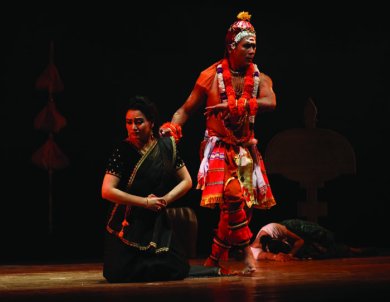
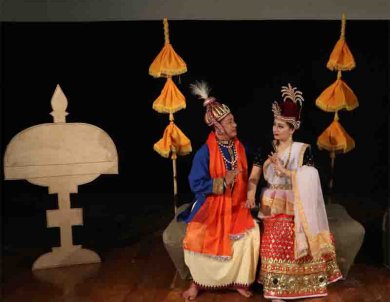
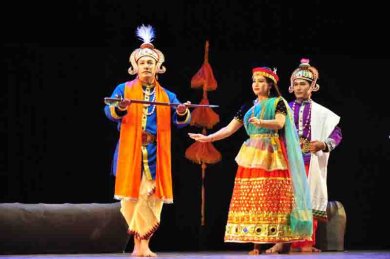
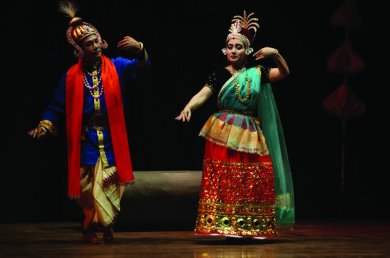
Debjani Chaliha has highlighted a very significant part of the history of Assam and Manipur in writing the script of the story of Princess Kuranga Nayani’s exploits. To recapitulate the story briefly, Kuranga Nayani was the daughter of King Joy Singh of Manipur, who had been saved by the Ahom king from the onslaught of the Burmese king. In return for this valuable service the king of Manipur entered into a marriage alliance with his daughter Kuranga Nayani and the Ahom King Swargadeo Rajeswar Singh. By dint of her qualities she had earned the position of the chief queen in King Joy Singh’s court. The passing away of King Joy Singh and the attack of the Moran tribe in the fledgling kingdom of Lakshmi, the younger brother of Joy Singh, were the two setbacks in the Ahom kingdom that followed one after the other, and it was Kuranga Nayani, who used her wits and successfully got rid of the Moran ruler from the land of the Ahoms and reinstated Lakshmi as the rightful ruler of Assam. This rich story of wars, court intrigues and romance in the hands of the talented choreographer Th. Chaotombi Singh, trained by Maya Rao, choreographer par excellence, left no loose ends for critiquing. The dance drama provided blood and gore in the first scene, where we saw Burmese soldiers attack the kingdom of Manipur bringing about cruelty and havoc in its wake, not sparing even women and children. In the offer of help by King Swargadeo Rajeswar Singh of Ahom to the hapless king of Manipur facing near defeat the power of friendship was seen. The dutiful daughter agreeing to follow the wishes of her father was sensitively portrayed. The procession of the princess bride-to-be from her parental home in Manipur to her would-be groom’s kingdom in Ahom, with gifts carried by her royal entourage was a visual grandeur, more so because of the passing landscape of the two different places. The villagers gathering in strategic positions to see the grand procession was a choreographic marvel. The princess bride – Chandan Devi - was an epitome of beauty as evidenced by her body language and her graceful swan like walk. The scene of the marriage designed by O. Jiten Singh was typical of Assam - the kingdom of Swargadeo was in the capital city of Rongpur in Assam, presently known as Shivsagar. The bride clad in Manipuri potloi costume and the groom in Assamese attire was a pleasing picture. The Bihu and other dances presented at the king’s court for the bride and the groom followed by rituals and a symbolic dance of the newly married couple showcasing their life of love was aesthetically pleasing. Thang Ta, the martial art form of Manipur, was used in the war scenes. The poignant moment of the cruel Moran, Ragho Borbaruah, came when Kuranga Nayani tricked and killed him on the day of Bahag Bahu. 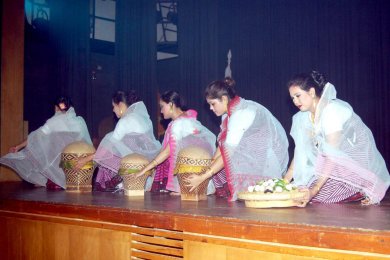
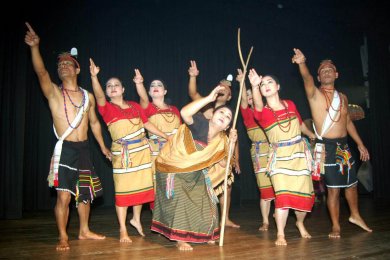
The transformation of Kuranga Nayani from a delicate beauty to a warrior was sensitively portrayed by Chandan Devi. The war scenes with sword fights were watched with bated breath. K. Jadu Singh, Th. Nokuljit Singh, Th. Kangjamba Singh, Y. Inaocha Singh, O. Jiten Singh, P. Bilash Singh and N. Surendrajit Singh were the powerful male dancers, who left the audience hankering for more. The female dancers R.K. Jayatisana Devi, O. Debala Devi, Th. Parul Devi, B. Sanjita Devi, P. Reepa Devi and T. Piyainu Devi effectively played their parts. The sound of the pena and the pung by L. Leibakmacha Singh and the duo K. Jadu Singh and Th. Nokuljit Singh spelt the typicality of a production that is Manipur’s very own. Music composer Ibopishak Singh enhanced the quality of the production. Production in-charge W. Lokendrajit Singh was responsible for the success of the program. Kuranga Nayani was premiered at Imphal by JNMDA last year. Jawaharlal Nehru Manipur Dance Academy presented it recently in Kolkata. The vision of Upendra Sharma, the Director of JNMDA, in bringing Kuranga Nayani to Kolkata was an exchange of culture in the true sense. Tapati Chowdurie learnt dance from Guru Gopinath in his dance institution Natana Niketan in Madras. For a brief period, she was with International Centre for Kathakali in New Delhi. Tapati has a Master's degree in English Literature. Presently, she is a freelance writer on the performing arts. |